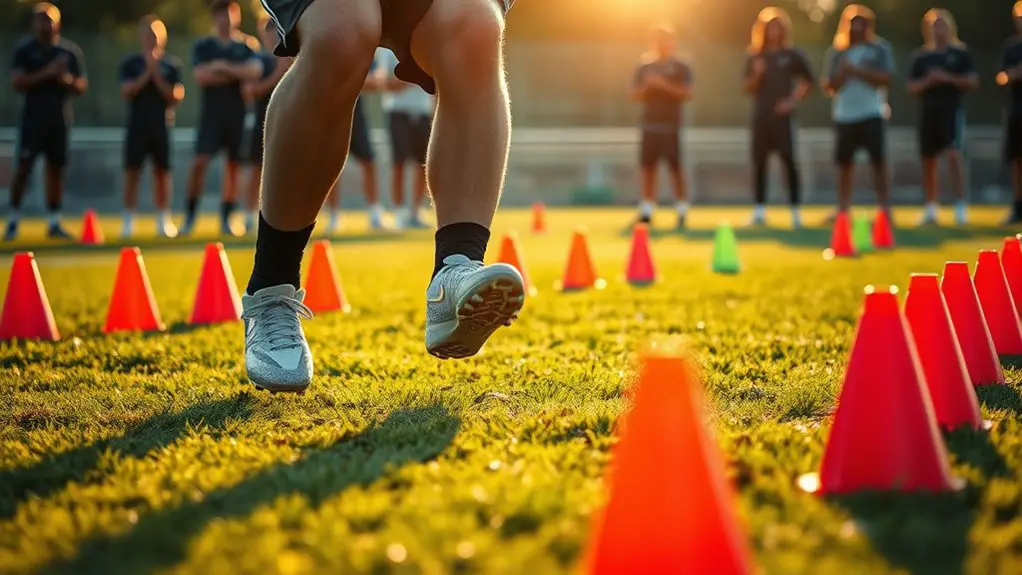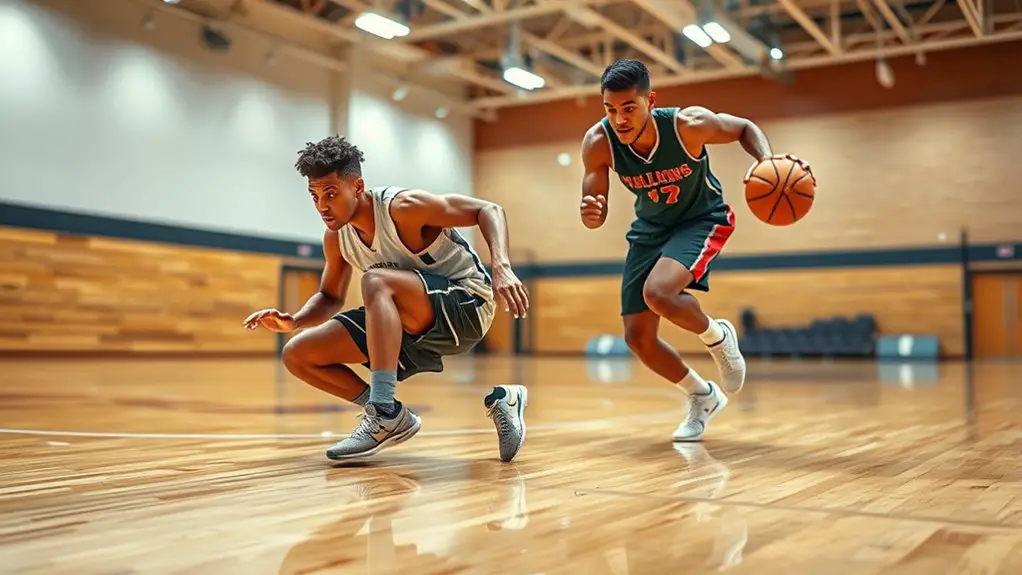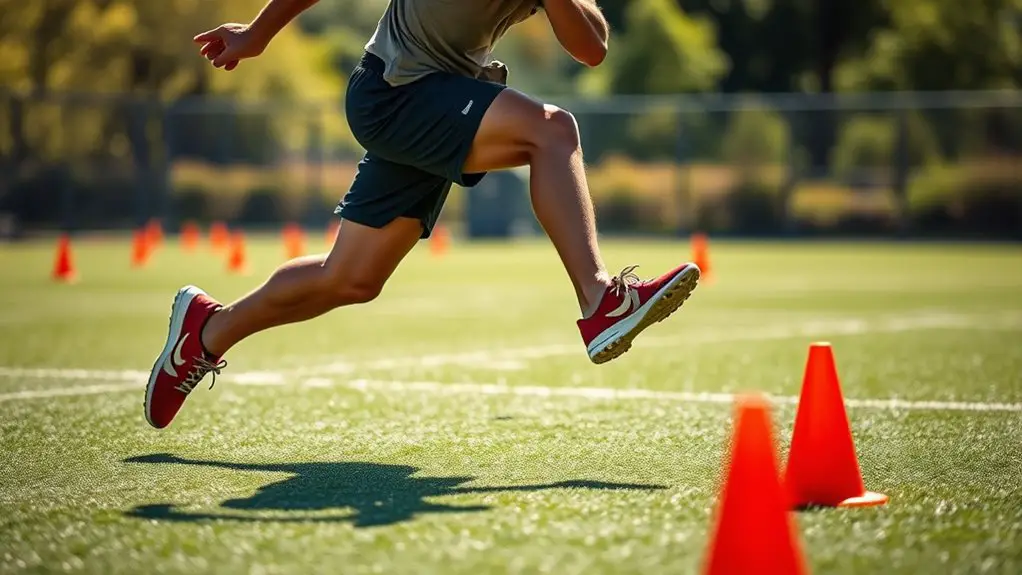To boost your agility as a football player, incorporate ladder drills for quick feet and cone drills for sharp direction changes. Shuttle runs help with acceleration and deceleration, while plyometric exercises like box jumps enhance explosiveness on the field. Don't forget agility hurdles to improve your coordination and balance. These drills can transform your performance during games. Stick with us, and you'll discover even more effective techniques to elevate your game.
Ladder Drills for Quick Feet
Ladder drills are a fantastic way to enhance your quickness and footwork on the field. By incorporating these drills into your training, you'll develop agility that allows you to maneuver effortlessly during games. Just imagine the freedom you'll feel as you sprint past defenders, your feet flying in perfect rhythm. Start with basic patterns like the two-foot in each box or lateral shuffles, then progress to more complex sequences. The beauty of ladder drills is their versatility; you can do them anywhere, anytime. Plus, they're a great way to break up the monotony of traditional workouts. Embrace the challenge, and watch your confidence soar as your footwork becomes sharper and more explosive. Get ready to release your potential!
Cone Drills for Direction Change
After honing your footwork with ladder drills, it's time to focus on how to change direction swiftly and effectively. Cone drills are your go-to exercises for mastering sharp turns and explosive movements. They'll help you break free from defenders and navigate the field like a pro.
Mastering cone drills will elevate your agility, allowing you to change direction swiftly and outmaneuver defenders on the field.
Here are three key cone drills to try:
- T-Drill: Sprint forward, shuffle laterally, and backpedal, perfecting your agility in all directions.
- Zig-Zag Drill: Weave through cones, mimicking game-like scenarios where quick direction changes are essential.
- Box Drill: Sprint, shuffle, and backpedal around a square, enhancing your ability to pivot and accelerate.
Incorporate these drills into your routine, and watch your agility soar!
Shuttle Runs for Acceleration and Deceleration
Shuttle runs are essential for developing both acceleration and deceleration, making them a must-have in any football player's training regimen. These drills help you improve your ability to sprint quickly in different directions and come to a sudden stop when needed. To perform shuttle runs, set up two cones about 10-20 yards apart. Start at one cone, sprint to the other, touch the ground, and sprint back. Focus on explosive starts and controlled stops to enhance your speed and agility. Incorporate shuttle runs into your workouts regularly, adjusting the distance and intensity as you progress. By mastering this drill, you'll not only elevate your game but also gain the freedom to move effortlessly on the field.
Plyometric Exercises for Explosiveness
Building on the foundation of shuttle runs, plyometric exercises can greatly enhance your explosiveness on the field. These dynamic movements help you release your power, allowing you to break free from defenders and make those game-changing plays. Here are a few plyometric exercises to evaluate:
- Box Jumps: Leap onto a sturdy platform, feeling the surge of energy as you land softly.
- Depth Jumps: Step off a box, then explode upward, harnessing gravity to propel you higher.
- Broad Jumps: Spring forward in one powerful movement, covering ground like a gazelle chasing its prey.
Incorporating these drills into your training can elevate your performance, giving you the freedom to dominate every play. Embrace the challenge and watch your explosiveness soar!
Agility Hurdles for Coordination and Balance
Though you might feel confident in your speed, agility hurdles can greatly enhance your coordination and balance on the field. Incorporating these hurdles into your training routine allows you to develop quick footwork and refine your body control. Set up a series of hurdles and practice jumping over them, focusing on maintaining a low center of gravity. This'll help you stay agile while making sharp cuts or dodging defenders during games. You can also mix in lateral movements to improve your side-to-side balance. Remember, the goal is to flow freely and naturally, so don't rush it. As you get comfortable, challenge yourself with different patterns and speeds, pushing your limits while enjoying the freedom of movement agility hurdles provide.
Frequently Asked Questions
How Often Should I Perform Agility Drills Each Week?
Like a river flowing smoothly, you should aim for agility drills two to three times a week. This rhythm balances growth and recovery, allowing you to dance through challenges with grace while sharpening your skills.
What Age Is Appropriate for Starting Agility Training?
You can start agility training as early as age 6 or 7. It's crucial to focus on fun and fundamental skills at this age, allowing you to develop coordination and movement without pressure.
Can Agility Drills Reduce the Risk of Injuries?
You might think agility drills are just fancy footwork, but they're actually your secret weapon! They can substantially reduce injury risks, keeping you agile and ready to dominate the field while feeling free and unstoppable.
How Do I Measure My Agility Progress?
To measure your agility progress, track your speed and times during drills. Use cones for quick turns, and compare results over weeks. You'll see improvements in your reaction time and overall performance.
Are There Specific Drills for Different Positions in Football?
Yes, there're specific drills tailored for different positions in football. For instance, wide receivers focus on quick cuts, while linemen enhance footwork and balance. It's essential to choose drills that align with your position's demands.




